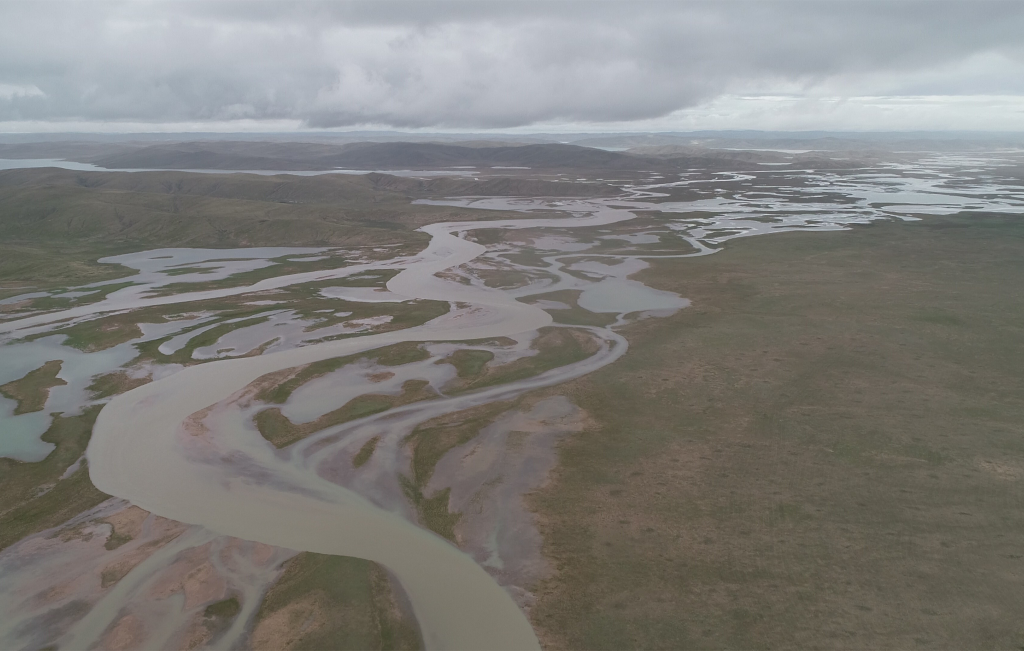Another watershed law! Four highlights of the draft yellow river protection law
Xinhua News Agency, Beijing, December 21st Title: The draft of the Yellow River Protection Law was first submitted for deliberation! Facing the imbalance of water and sediment, shortage of water resources and ecological fragility … …
Xinhua News Agency "Xinhua Viewpoint" reporters Liu Shiping and Wang Yueyang

The Yellow River in Qinghai. Xinhua News Agency reporter Liu Shiping photo
Another watershed law after the Yangtze River Protection Law — — The draft of the Yellow River Protection Law was first submitted to the the National People’s Congress Standing Committee (NPCSC) meeting for deliberation on December 20th. "Xinhua Viewpoint" reporter interviewed relevant experts on the important points of the draft law.
Aspect 1: Why special legislation?
Article 1 of the draft clearly states that this Law is formulated in order to strengthen the ecological protection of the Yellow River basin, ensure the An Lan of the Yellow River, promote the economical and intensive utilization of water resources, promote high-quality development, protect and carry forward the Yellow River culture, and promote the construction of ecological civilization.
The Yellow River is the mother river of the Chinese nation. Li Guoying, Minister of Water Resources, said at the the National People’s Congress Standing Committee (NPCSC) meeting that there are still some outstanding difficulties and problems in the Yellow River Basin. The management system of the Yellow River Basin needs to be improved, the planning and coordination are insufficient, the control measures need to be strengthened, and the ecological protection and restoration, the rigid constraint of water resources, the regulation of water and sediment, flood control safety and pollution prevention and control systems need to be improved, which need to be solved urgently by enacting the Yellow River Protection Law.
"Specially legislating for the Yellow River can provide more overall and systematic legal protection for the Yellow River Basin and make up for the shortcomings of the current decentralized legislation." Qin Tianbao, director of the Institute of Environmental Law of Wuhan University and vice-president and secretary-general of the china law society Environmental Resources Law Research Association, said that the provisions of some existing laws related to the Yellow River are vague, lack of operability, lack of coordination, and even conflict, resulting in outstanding problems of divided management and extensive management in river basin management practice.
Qiao Xixian, deputy chief engineer of the Yellow River Conservancy Commission of the Ministry of Water Resources, believes that the Yellow River is different from other major rivers such as the Yangtze River, and its particularity is manifested in the relationship between water and sediment, soil erosion, suspended rivers on the ground, water shortage and so on, and it is urgent to legislate specifically on the Yellow River.

Xiaolangdi Reservoir in the Yellow River flood discharge in autumn in 2021. Xinhua News Agency reporter Liu Shiping photo
Aspect 2: How to deal with the relationship between water and sediment?
Jiuqu Yellow River Wan Li Sand. Statistics show that the average annual sediment transport of the Yellow River for many years is 1.6 billion tons, ranking first among the major rivers in the world. The average runoff for many years is only over 50 billion cubic meters, with less water and more sediment. A large amount of sediment is deposited in the lower reaches of the river, forming a world-famous suspended river.
"62% of the Yellow River’s water production comes from Lanzhou and above, and 90% of the sand production comes from the middle reaches. The incoming water and sand production are from different sources, and the relationship between water and sand is not harmonious, which is easy to cause problems such as flood control, water supply and ecology." Josie said now.
In this regard, the draft firmly grasps the "bull’s nose" of regulating the relationship between water and sediment to ensure the An Lan of the Yellow River.
The draft proposes to organize the construction of water and sediment regulation and flood control and disaster reduction engineering system in the Yellow River basin, and improve the water and sediment regulation and flood control and ice prevention dispatching mechanism; Improve the water and sediment regulation system based on major water projects such as key reservoirs, and play the role of joint water and sediment regulation; Planning and licensing system shall be implemented for sand mining in the Yellow River basin; Breeding in Sanmenxia, Xiaolangdi, Guxian, Luhun and Hekoucun reservoir areas shall meet the requirements of water and sediment regulation and flood control, and it is forbidden to adopt cage, purse seine and river-blocking and net-pulling breeding methods.
Chang Jiwen, deputy director of the Institute of Resources and Environmental Policy of the State Council Development Research Center, believes that the series of measures listed in the draft make up for the gaps in the existing flood control law and take into account the particularity of the Yellow River protection. "The regulations on water and sediment regulation and flood control safety have guaranteed the water safety of the Yellow River."

Ningxia Yellow River Diversion Ancient Irrigation Area. Xinhua News Agency reporter Liu Shiping photo
Aspect 3: How to solve the shortage of water resources and the contradiction between supply and demand?
According to the statistics of the Yellow River Conservancy Commission, the per capita water resources in the Yellow River basin is only 27% of the national average, which is an extremely water-deficient area. At the same time, the development and utilization rate of water resources in the Yellow River is as high as 80%, far exceeding the ecological warning line of 40% in general river basins.
The reporter saw that keywords such as "unification", "strict restrictions" and "mandatory" frequently appeared in the fourth chapter of the draft.
The draft proposes that the state should uniformly allocate the water quantity of the Yellow River and control the total amount of water taken. The state implements unified regulation of water resources in the Yellow River basin; In addition to water for people’s livelihood, the Yellow River Basin water resources overloaded areas shall not be allowed to add water permits; The Yellow River basin strictly limits the construction of high water consumption projects; Water users in the Yellow River Basin and the relevant county-level administrative areas in the Yellow River water supply areas of Henan and Shandong provinces shall strictly implement the mandatory water quota for high-water consuming industries and services. Those who exceed the mandatory water quota shall implement water-saving technological transformation within a time limit.
Chang Jiwen said that the Yellow River is short of water resources and the contradiction between supply and demand is prominent. The draft strengthens the economical and intensive utilization of water resources, from surface water to groundwater, from domestic water for urban and rural residents, basic ecological water to agricultural industrial production water, and makes comprehensive and strict regulations on the utilization of water resources in the Yellow River Basin.
Josie now believes that the contradiction between supply and demand of water resources has become the biggest bottleneck restricting the high-quality development of the Yellow River Basin, and the development of agriculture and key energy and chemical bases in the Yellow River Basin is seriously restricted by water resources. At the same time, the level of saving and intensive utilization of water resources needs to be further improved.
"The draft establishes a planning water resources demonstration system, regards water resources as the biggest rigid constraint, rationally plans the development of population, cities and industries, resolutely suppresses unreasonable water demand, vigorously develops water-saving industries and technologies, vigorously promotes agricultural water conservation, and implements water-saving actions in the whole society to promote the transformation of water use methods from extensive to economical and intensive." Josie said now.

Siltation dam in Suide, Yellow River Basin. Xinhua News Agency reporter Liu Shiping photo
Aspect 4: How to protect fragile ecology and strengthen effective restoration?
The Yellow River Basin constitutes an important ecological barrier in China and an ecological corridor connecting the Qinghai-Tibet Plateau, the Loess Plateau and the North China Plain. At present, the ecological fragility of the Yellow River basin is mainly manifested in the following aspects: the water conservation capacity in the upper reaches is still low, the problem of soil erosion in the middle reaches is still outstanding, and the pressure on ecological protection of rivers and lakes continues to increase.
According to the requirements of ecological protection and restoration in different regions such as the source region of the Yellow River, the Loess Plateau, estuaries and deltas, the draft stipulates different ecological protection and restoration systems.
The draft proposes that the state should co-ordinate the construction of the nature reserve system in the Yellow River Basin; It is forbidden to engage in mining, sand mining, fishing and hunting activities within the management scope of rivers and lakes such as Zhaling Lake, Eling Lake, Yuegu Zongliequ and Maduo River and Lake Group in the upper reaches of the Yellow River, so as to maintain the natural state of rivers and lakes; Strengthen the protection and restoration of the ecosystem in the upper and middle reaches of the Yellow River; Support the whole ditch management in the upper and middle reaches of the Yellow River Basin.
The draft also proposes that it is forbidden to carry out production and construction activities that may cause soil erosion in areas with serious soil erosion and fragile ecology in the Yellow River Basin; Formulate and implement the regulation plan of the Yellow River estuary, rationally arrange and oceans drain the golden river Road, strengthen the regulation of the estuary, and ensure the smooth flow of the estuary and the safety of flood control and ice prevention at the estuary.

Swan in Sanmenxia of the Yellow River. Xinhua News Agency reporter Liu Shiping photo
Qin Tianbao believes that the draft puts the establishment of a river basin coordination mechanism at the core, and forms an institutional mechanism for coordinating major policies, major plans and major issues of river basin protection, providing a legal basis for the formation of an institutional mechanism for coordinated management of the upper, middle and lower reaches, rivers, lakes and reservoirs, left and right banks, and main tributaries, and the corresponding ecological compensation mechanism.
Chang Jiwen said that the Yellow River ecosystem is an organic whole, and the draft not only considers the problem from the overall "chess game" perspective, but also fully considers the differences between the upper, middle and lower reaches. Referring to the successful experience of the Yangtze River Protection Law, the draft "names some areas in need of protection" and puts forward specific ecological protection and restoration measures, which are more targeted for the ecological protection and restoration of the Yellow River.
Experts pointed out that the Yellow River Protection Law will be a law to promote ecological protection and high-quality development of the Yellow River Basin. Article 73 of the draft emphasizes "promoting the optimization and adjustment of industrial structure, energy structure and transportation structure, and promoting carbon neutrality in peak carbon dioxide emissions", and the concepts of "peak carbon dioxide emissions" and "carbon neutrality" are written into the draft, which shows that the legislation keeps pace with the times.





































